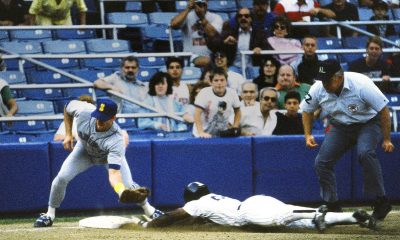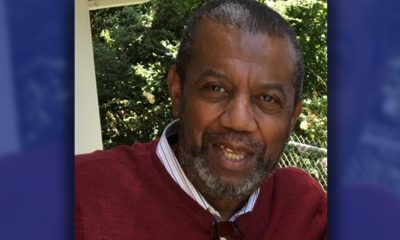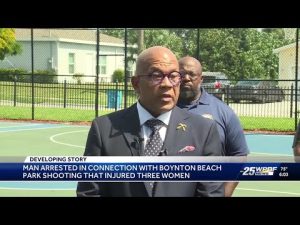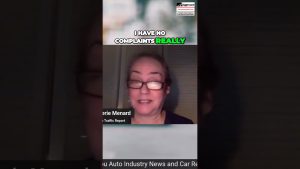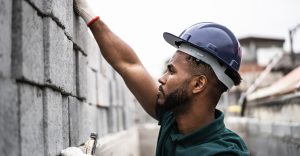Raiders
Vikings Ready To Unveil U.S. Bank Stadium, Can Raiders Follow Suit?
Minneapolis, MN – No relocation needed. They fought hard to stay in their own market and the reward, a new stadium. By late July, the Minnesota Vikings will unveil their new stadium after twelve years of negotiating, the vision has finally come to fruition. A unique partnership between team owners and the public created the funds needed to not only bring a new stadium to the area along with new opportunities to the city of Minneapolis.
The project has already employed up to 4,000 construction jobs and will continue to employ more once the stadium is schedule to open in time for the 2016 NFL season. The city of Minneapolis is expected to bring more jobs and housing in the area where the stadium is located. While it’s been an arduous process in getting approvals and funding, more than 275 Minnesota businesses have contributed to the design and construction of U.S. Bank Stadium with approximately 90% of the construction dollars, or more than $700 million, going back to Minnesotans.
“The process to get the stadium approval, work the deal, and assemble the partnership was complicated,” Owner/President Mark Wilf said. “It was difficult at times but in the end, a project of this magnitude took a lot of partners to come together. I think we’ll have the finest football stadium in the country.”
The owners decided they will do whatever it takes to bring a new stadium to Minneapolis. The Wilfs dedicated their time to three primary areas since taking ownership in 2005; building a winning football team, a new stadium and bringing a Championship to Minnesota which will provide the best game day experience for Vikings fans, and positively impacting the Minneapolis-St.Paul community and the entire state of Minnesota.
The Vikings have made strides in developing a state-of-the art, multi-use stadium in downtown Minneapolis. The stadium, which gained state approval in May 2012, is set to open end of July for a ribbon cutting ceremony. The stadium is almost complete and has many features that will impact the National Football League in being one of the best premiere stadiums in the league. Not to mention securing two of the world’s best sporting events, Super Bowl 52 in 2018 and the NCAA Final Four in 2019.
NFL teams hoping to build a new stadium in their cities such as the Oakland Raiders should take a page out the Vikings book. Governor Mark Dayton signed the stadium bill in 2012 and later strongly defended the $1.1 billion cost to build the stadium. Had the state not approved the new stadium, than it would’ve been the Vikings moving to Los Angeles. Following on the heels of the Minnesota Twins who moved to their new ballpark in 2010 after sharing the Metrodome with the Vikings for 28 years. The Vikings new they would be next to get a deal done.
“It was clear we needed to have a local partner to get a stadium deal done,” said Lester Bagley, Executive Vice President Public Affairs & Stadium Development. “It wasn’t just the roof collapsing, that got us a stadium deal done. It took a long time to get a coalition effort, business laborer elected officials to get it done. It was a long discussion following on the heels of the Twins deal who shared the Metrodome with us.”
“It was essentially our Governor and Republican Legislature leaders who said let’s take a vote on the stadium,” Michelle Kelm-Helgen, Chair of Minnesota Sports Facility Authority said. “50% of the money came from the public while the other 50% came from the team.”
The new stadium has already created jobs and a $400 million development project involving two office towers, retail, housing and a two-block City park constructed adjacent to U.S. Bank Stadium. In 2012, the public (City of Minneapolis and the state of Minnesota) put up 498 million while the team added $477 million along with a private source. Four years later, the Vikings added an additional $115 million beyond the original $475 team/private commitment.
Many of the features that will standout for this new stadium is an elevated pedestrian bridge and the only ETFE (ethylene‐tetra‐fluoro‐ethylene) roof on a sports facility in the U.S.. Designed to let light in like glass, the ETFE roof gives fans the best of both worlds: an outdoor experience in a climate‐controlled environment. Two high quality LED video boards will be located in the east and west end zones estimated in size at 120’ x 68’ (8,160 square feet) and 88’ x 50’ (4,400 square feet).
“The Metrodome was so dark you couldn’t determine if it was blue sky day or raining and lightening,” said John Wood, Senior VP of Mortenson Construction. “Now you can see all of that with the ETFE roof.”
U.S. Bank Stadium will also have a collection of art, hundreds of pieces specifically commissioned from primarily local Minnesota artists. The Art will span eight mediums and three themes, including celebrating the State of Minnesota, honoring Minnesota sports moments and saluting Vikings past and present. A nearby park is also a key feature of a five-block redevelopment next to the stadium. Wells Fargo, (state’s largest bank) is spending $300 million on two 17-story office towers next to the park and stadium.
The Vikings chose a local construction company (Mortenson Construction) to build U.S. Bank Stadium which was designed by Dallas‐based HKS Architects who also designed Lucas Oil Stadium and AT&T Stadium. The next task is installing a
world‐class technology infrastructure that complements the unmatched game‐day atmosphere of a Vikings home game, and providing the most social experience in the NFL. The Wi‐Fi is capable of accommodating every fan inside the stadium and the bandwidth will be able to accommodate expanded capacities (i.e. 70,000 at Super Bowl LII).
In hopes of duplicating Levi’s Stadium, home of the San Francisco 49ers. Levi’s is the most high-tech sports venue in the NFL. In the heart of Silicon Valley, the team spent a significant sum of money in building a high-tech infrastructure. 400 miles of cabling, and 40 gigabits per second of available bandwidth which is 40 times more Internet bandwidth capacity than any known U.S. stadium, and four times greater than the standard NFL stadiums today. The Vikings hope to top that and become the best high-tech stadium in the NFL.
“We came up with this catchy slogan in house, ‘drive way to drive way’,” John Penhollow, VP of Corporate & Technology Partnerships said. “When you leave your house in the morning, can we somehow affect your journey from your house to our stadium.”
Approximately 1,300 access points will be installed in “clam shells” in the hand rails – proprietary technology that ensures prime frequency and coverage. The access points are typically installed in premium spaces; the Vikings will be stadium‐wide. A neutral host distributed antenna system will ensure a all major wireless carriers creating reliable, high‐speed mobile connectivity for users. Through Beacon technology, U.S. Bank Stadium will leverage geofencing to connect with fans in and outside U.S. Bank Stadium.
A new Vikings app and U.S. Bank Stadium app will be released soon, that will include access to robust content, digital ticketing, fan loyalty programs, wayfinding in and outside of the stadium, food and beverage offerings, merchandise and other fan engagement content. Highlights of app will include game action replays from various angles, express food and beverage ordering, and push notifications containing messages from players and coaches.
“We want to create a family-friendly environment and a positive experience for all fans at our football games,” said Kevin Warren, Vikings Chief Operating Officer. “I saw a pod while traveling and immediately thought we need to bring this to our fans. We want to encourage breastfeeding mothers to nurse where they feel comfortable, and if that’s at a football game, than we can accommodate. We are always striving to create the most positive workplace environment within our organizations and the pods in our offices will benefit many of our female employees.”
Another exciting feature at the new stadium will be the Mamava breastfeeding pods. Designed for breastfeeding mothers, this pod will offer privacy and enough space for a family. The Vikings are the first NFL team to partner with Mamava. These pods will be available in the suites, upper levels and lower levels throughout the stadium. The single units contains comfortable benches, an electrical outlet for plugging in a breast pump and a door that can be locked for privacy. The 4-foot by 8-foot suite is meant for individual use but can fit mothers with babies and other children in tow.
The Vikings new home will hold about 66,200 fans, expendable to 70,000 for events like the Super Bowl LII in 2018. The facility will feature six different suite options totaling 131 individual suites range in capacity from 10-24 fans. The most unique option is the Turf Suites (23) located directly on the field just 25 feet away from the playing field, giving fans a true on-the-field experience. Six clubs will include Club Purple, the stadium’s dynamic, all‐inclusive fantasy sports HQ that connects fantasy sports content to the live game. Just 100 plus days away from until the ribbon cutting ceremony. Stay tuned.
Bay Area
IN MEMORIAM: John Madden, Oakland Raiders Super Bowl Winning Coach, Dies at 85
“We all know him as the Hall of Fame coach of the Oakland Raiders and broadcaster who worked for every major network, but more than anything, he was a devoted husband, father and grandfather,” NFL Commissioner Roger Goodell said.

By Bay City News
John Madden, who won a Super Bowl with the Oakland Raiders and went on to be a television commentator and namesake of a popular football video game series, has died at the age of 85, the National Football League announced on Dec. 28, 2021.
No other information about a cause of death was immediately released.
Madden, who grew up in Daly City, led the Oakland Raiders to a Super Bowl victory in 1977, then went on to highly successful careers in TV and video games, and was recently the subject of a documentary titled “All Madden.”
“We all know him as the Hall of Fame coach of the Oakland Raiders and broadcaster who worked for every major network, but more than anything, he was a devoted husband, father and grandfather,” NFL Commissioner Roger Goodell said.
Madden’s death prompted widespread reactions on social media from those who knew or admired him.
The Raiders, who have since moved to Las Vegas, wrote “A brilliant coach. A loyal and trusted friend. A Raider.”
Gov. Gavin Newsom wrote, “Tonight we mourn John Madden — he redefined the role of a sports broadcaster — his voice as recognizable as anyone who ever did the job. He hoisted a Super Bowl trophy with CA’s own Oakland Raiders. Our thoughts are with his family as we mourn this incredible man.”
Oakland Mayor Libby Schaaf wrote, “I join all in mourning + honoring SuperBowl-winning coach John Madden. He was a great personality who truly loved #Oakland. When his grandson played at O’Dowd, John was as enthusiastic about the Dragons as any NFL team. We will miss him!”
San Mateo County Board of Supervisors president David Canepa wrote, “RIP John Madden. A 1954 graduate of Jefferson High School in Daly City and Super Bowl winning coach for the Oakland Raiders. He did so much for Daly City!”
Featured
City Seeks to Work With A’s, Major League Baseball To Keep Team in Oakland
City Council leaders said it’s incorrect “that the City Council is delaying or refusing to consider the A’s project proposal,” at Howard Terminal.
Leaders of the Oakland City Council told the head of Major League Baseball in a May 14 letter that they are willing to work with the A’s baseball team to keep it from moving out of the city.
Oakland recently lost both its National Football League franchise the Oakland Raider’s to Las Vegas and the Golden State Warriors to San Francisco.
The letter comes just days after MLB told the Oakland A’s to look for another city to play while pursuing a waterfront park in Oakland.
“The Oakland City Council is committed to negotiating in good faith for a strong future for the A’s in Oakland, and we invite the A’s and MLB to do the same by agreeing not to seek relocation while the A’s complete the (stadium at the Charles P. Howard Terminal) project process,” the letter begins.
But officials in Las Vegas revealed on May 12 on Twitter through Mayor Carolyn Goodman that they have been talking with the A’s since 2019 and they are excited.
City Council leaders said it’s incorrect “that the City Council is delaying or refusing to consider the A’s project proposal,” at Howard Terminal.
Rather, many, such as city staff have been working to bring the proposal to the council for potential approval.
But the A’s have been working on the project for nearly five years, A’s president Dave Kaval said in February. Opposition, too, has mounted against the Howard Terminal site and in favor of a new stadium at the current Oakland Coliseum site.
The City Council’s letter says that MLB has concluded without sufficient support “that the Coliseum site is not viable.”City Council leaders asked in the letter for the materials MLB reviewed to draw that conclusion.
The council’s letter is signed by council President Nikki Fortunato Bas, Vice Mayor and Councilmember At-Large Rebecca Kaplan and Councilmember Carroll Fife, who represents downtown and West Oakland.
The Howard Terminal site is near both downtown and West Oakland.
City Council leaders are willing to meet with MLB officials and the A’s ownership, the letter says, “to thoughtfully move forward.”
Council leaders said the A’s leadership recently changed their requests.
“Rather than send forward full completed deal terms for consideration,” the A’s demanded that the council vote on summary deal terms.
“Council leadership expressed willingness to explore this request, and met with the A’s staff and other stakeholders to seek how best to move forward,” according to the letter.
Council leaders were in the process of scheduling a vote on the summary deal terms before their summer recess when MLB told the A’s to seek a new home while it pursues a waterfront ballpark in Oakland.
“This relocation announcement came without giving the council an opportunity to receive and vote on a proposal and did not even wait for the time requested for the vote,” the letter says.
“Since the request was for a vote by August, why would you announce permission to explore relocation, prior to the date of the requested vote, if the request had been a sincere one?” the letter said.
Council leaders asked MLB to confirm its intentions.
“Can you confirm definitively, that if the council were to take such a vote for a term sheet regarding the A’s, that you would prohibit any action to seek or pursue relocation during those next steps?”
Kaplan’s staff confirmed late on the afternoon of May 14 that a vote on the summary deal terms will be scheduled for before the August recess.
Bay Area
City Reacts as A’s Threaten to Leave
The A’s said on Tuesday said they will start looking into relocating with the backing of Major League Baseball.

The Oakland Athletics made a public threat this week to leave Oakland if the City Council does not accept their latest proposal by the end of June to build a baseball stadium and huge real estate complex at the Howard Terminal at the Port of Oakland.
The A’s said on Tuesday said they will start looking into relocating with the backing of Major League Baseball.
A’s owner John Fisher said in a statement, “The future success of the A’s depends on a new ballpark. Oakland is a great baseball town, and we will continue to pursue our waterfront ballpark project. We will also follow MLB’s direction to explore other markets.”
A’s President Dave Kaval told the Associated Press on Tuesday, “I think it’s something that is kind of a once-a-generational opportunity to reimagine the waterfront. We’re going to continue to pursue that, and we’re still hopeful that that could get approved, but we have to be realistic about where we are with the timelines.”
Many residents are angry at the A’s aggressive stance, especially since the team’s new proposal is vague on details and puts the city and its residents on the hook for nearly one billion dollars in infrastructure improvements plus over $400 million in community benefits the A’s have pledged but instead would be handed off to taxpayers.
Reflecting the reaction of some residents, Tim Kawakami, editor-in-chief of the SF Bay Area edition of The Athletic, tweeted, “I just don’t see the municipal validation in kowtowing to a billionaire who won’t spend much of his own money to build a new stadium that will make him many more billions.”
Mayor Libby Schaaf says she is open to the A’s proposal, and Council members want more details on its financial impact on the city and its taxpayers,
Councilmember Loren Taylor told the Oakland Post in an interview: “We know they are looking for alternative locations. It is something that has to be factored in. Our commitment is to work to keep the A’s in Oakland but to do it in way that protects the interests of the city and is the best deal for the people of Oakland.”
Said Councilmember Treva Reid:
“My commitment will always be to the residents of East Oakland and ensuring strong community benefits and economic development. I appreciate the contribution of the Athletics … However, the Council must have an adequate amount of time to thoroughly evaluate their proposed offer to ensure Oakland residents receive a fair, transparent and equitable deal.”
In her statement, Mayor Schaaf, who has long been a backer of the A’s real estate development near Jack London Square, said, “We share MLB’s sense of urgency and their continued preference for Oakland. Today’s statement makes clear that the only viable path to keeping the A’s rooted in Oakland is a ballpark on the waterfront.
“Now, with the recent start of financial discussions with the A’s, we call on our entire community — regional and local partners included — to rally together and support a new, financially viable, fiscally responsible, world class waterfront neighborhood that enhances our city and region and keeps the A’s in Oakland where they belong.”
Major media outlets, often boosters of super- expensive urban developments, are unenthusiastic about the A’s proposal and the team’s pressure on the city to go along with its demands.
In an article, the San Francisco Chronicle’s Scott Ostler wrote, “Get the message, Oakland? Vote to approve the A’s plan and commit to kicking in $855 million for infrastructure for the A’s new ballpark and surrounding village around Howard Terminal or kiss your lovable little baseball team goodbye.
“It’s called power politics, folks.”
In an editorial, the Mercury News and the East Bay Times wrote,” The team has thrown down a greedy and opaque demand that the city of Oakland approve a $12 billion residential and commercial waterfront development project that happens to include a new ballpark — and requires a massive taxpayer subsidy.
“If that’s the best the A’s can offer, the city should let them go.”
Ray Bobbitt of the African American Sports and Entertainment Group told the Oakland Post, “These are bully tactics. You either give me the money or I’m leaving. I don’t think that’s the way to work with the community.
“Do it in a way that’s respectful of the people. If you want to play hardball, I don’t think it’s a tactic that works these days.”
-
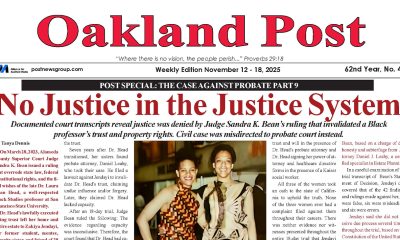
 Activism3 weeks ago
Activism3 weeks agoOakland Post: Week of November 12 – 18, 2025
-
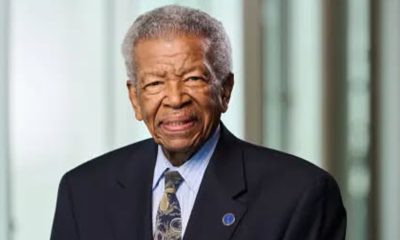
 Activism3 weeks ago
Activism3 weeks agoIN MEMORIAM: William ‘Bill’ Patterson, 94
-

 Activism3 weeks ago
Activism3 weeks agoHow Charles R. Drew University Navigated More Than $20 Million in Fed Cuts – Still Prioritizing Students and Community Health
-

 Bay Area3 weeks ago
Bay Area3 weeks agoNo Justice in the Justice System
-

 #NNPA BlackPress3 weeks ago
#NNPA BlackPress3 weeks agoLewis Hamilton set to start LAST in Saturday Night’s Las Vegas Grand Prix
-

 #NNPA BlackPress2 weeks ago
#NNPA BlackPress2 weeks agoBeyoncé and Jay-Z make rare public appearance with Lewis Hamilton at Las Vegas Grand Prix
-
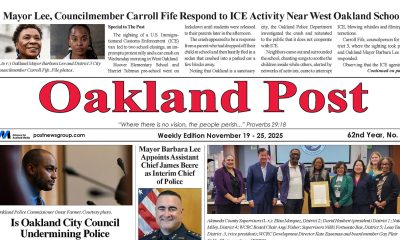
 Activism2 weeks ago
Activism2 weeks agoOakland Post: Week of November 19 – 25, 2025
-
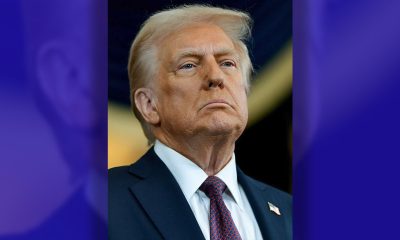
 #NNPA BlackPress3 weeks ago
#NNPA BlackPress3 weeks agoThe Perfumed Hand of Hypocrisy: Trump Hosted Former Terror Suspect While America Condemns a Muslim Mayor




